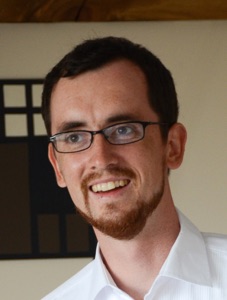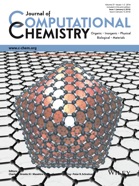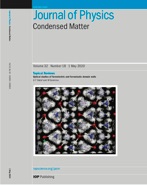
Contact
Office 2604
School of Physics and Astronomy
James Clerk Maxwell Building
Peter Guthrie Tait Road
The University of Edinburgh
Edinburgh, EH9 3FD
Phone +44 131 650 5824
Email a.hermann@ed.ac.uk
About Me
I hold the Chair of Computational Physics in the School of Physics and Astronomy at the University of Edinburgh. My research is in the field of computational materials science: using first-principles, parameter-free computing methods to predict and understand properties of materials – such as their stability, elastic, electronic, and optical attributes.
As member of the Centre for Science at Extreme Conditions, a part of my research focuses on the occurrence of new, interesting phases of various materials under conditions of extreme compression and high temperatures.
Join the Group
Students interested to join the group for a PhD are always welcome. Research projects can be found on the School’s web pages, together with information on the application process.
Potential undergraduate research projects are listed on the School’s wiki page (requires login).
News
11/2024: New funding from the Royal Society
The group has been awarded a Royal Society Exchange Grant to collaborate with the Hamprecht group at Heidelberg University on developing orbital-free density functional theory methods for crystal structure prediction. The grant will support academic exchange between our groups over the next 24 months.
10/2024: Complex ternary metal hydrides
Transition metals can form complex hydrogen-rich anions MHxn-, supported by alkali counter cations. Very hydrogen-rich stoichiometries can emerge, representing a route to stabilise metal polyhydrides at ambient conditions. Here, in collaboration with the Peña Alvarez group from Edinburgh, we demonstrate the high-pressure synthesis of two new hydrides of this type, NaReH8 and NaWH9, along with a sequence of phase transitions down to near-ambient pressure conditions. Our calculations are crucial to confirm the compositions and structures of these compounds. The results have just been published in Inorg. Chem.
09/2024: Yu Cai joins the group
Yu Cai joins the group as new doctoral student. Yu will work on developing machine-learned interatomic potentials for materials under extreme conditions – welcome to the group, Yu!
09/2024: David joins the group
David Lewis joins the group as new doctoral student. David will work on free energy calculations of planetary ices, in a jointly supervised project with Tetsuya Komabayashi from Edinburgh’s School of GeoSciences – welcome to the group, David!
09/2024: Ammonium fluoride under pressure
Ammonium fluoride, NH4F, is an ionic analogue to ice, forming tetrahedrally bonded network structures. However, pressure will eventually break this analogy: as predicted in a recent paper of ours, NH4F will depart from ice-like phases. The confirmation of this prediction, led by our experimental partners in Paris, Rome, and Lausanne, has just been published in Comms. Chem. X-ray diffraction and Raman spectroscopy data is complemented by our calculations that explore the unusual nature of the high-pressure phase transition.
06/2024: Room-temperature superconductor prediction
The main challenge around hydride superconductors is to lower the required operational pressures while retaining high superconducting transition temperatures. Our latest research, published in Proc. Natl. Acad. Sci., might just set the stage for the next big breakthrough. We predict that a ternary La-Sc-H material can exhibit superconductivity above room temperature at 150 GPa, and reach as high as 58°C under pressures up to 250 GPa.
05/2024: Sarah joins the group
Sarah Alnujaim joins the group as new doctoral student. Sarah will work on strongly correlated heavy fermion materials – welcome to the group, Sarah!
04/2024: Fully funded PhD position available
Our group has a fully funded PhD position available, to work on free energy calculations of planetary ices. This is a joint project with Tetsuya Komabayashi from the School of GeoSciences. See here for our local project description. Informal enquiries are welcome, applications will be considered until the position is filled.
01/2024: Superconductivity in covalent sodalite-like networks
The high-Tc superconductivity in polyhydrides emerges around clathrate-type motifs of the hydrogenic sublattice. Because bonding between atomic hydrogen is weak these structures can not be recovered to ambient pressures. Covalently bound clathrates should have much higher mechanical stability. In this work, just out in J. Mat. Chem. C, we explore Ga- and Ge-doped sodalite carbon networks, and predict superconductivity around nitrogen’s boiling point at ambient pressure.
01/2024: Thermal energy storage in phase change materials
Phase change materials (PCM’s) exhibit temperature-induced solid state phase transitions that can be exploited for thermal energy storage. Most commonly they transform from a crystalline to a plastic phase, with rotating entities on specific lattice sites at high temperature. Here, we investigate the PCM’s KBF4 and NaBF4. Our molecular dynamics simulations confirm the transition to a plastic phase in both compounds, supporting experimental diffraction experiments. The work, led by the Konar group, is now published in Chem. Mater.
01/2024: New H-C-N compounds under pressure
The elements hydrogen, carbon, and nitrogen are prevalent throughout the solar system. Under extreme conditions as found within planetary bodies, what types of compounds would they form? Here, high-pressure and -temperature synthesis results in two new phases of C(NH)2. Our calculations corroborate the experimental structural assignment. This collaborative effort is now published in Angewandte Chemie. Note that one of the new phases emerged from our previous exploration of the H-C-N-O chemical space.
01/2024: Alkali polyhydrides, revisited
The first computational investigations of metal polyhydrides were detailed studies of mixtures of alkali metals with hydrogen. Experimental evidence has always been sparse due to challenging synthesis conditions. Now, led by the Peña-Alvarez group, we provide evidence for the formation of sodium trihydride, NaH3, from diffraction and spectroscopy data combined with first principles simulations, as just reported in Front. Chem. The non-formation of any higher hydride is important here, and provides important benchmarks for future computational and experimental investigations.
12/2023: Water carriers in the deep Earth
The deep water cycle connects Earth’s surface water to storage reservoirs deep within Earth’s mantle, with exchange on geological timescales via plate tectonics and mantle convection processes. But what are these storage reservoirs? We previously suggested new mineral structures relevant in the upper mantle. Now, we explored new compounds stable at lower mantle conditions. A new iron silicate hydrate phase, FeSiO3.H2O, emerged as a promising materials candidate under those conditions. Based on large-scale structure searching of a large quasi-ternary chemical composition space, this work led by the Ma group at Jilin University has now appeared in Phys. Rev. B.
11/2023: Anderson localization of phonons in partially deuterated ice
When is the whole not the sum of its parts? In partially deuterated water or ice, rapid proton-deuteron exchange leads to an equilibrium distribution of H2O/HOD/D2O molecules. The vibrational properties of the isotopic mixture can not be explained via the isotopically pure substances. Instead, local H/D disorder leads to a multitude of vibrational eigenmodes and a broad distribution of frequencies, a phenomenon hitherto only seen in very dense H2-D2 mixtures. Our calculations, in collaboration with the Glenzer group from SLAC Stanford, explained the character of phonon localization in this simple system, and have been published in Phys. Rev. Research.
11/2023: Charge density wave mechanism in sulfur
Charge density waves (CDW’s) are of interest in 2D materials but also occur in elements – mostly under pressure. How does a CDW form and disappear as pressure is changed? Here, we investigate this question for elemental sulfur, in collaboration with the Friedemann group in Bristol, who tracked the CDW amplitude mode with Raman spectroscopy. Our calculations then helped explain how the disappearance of the CDW at the upper pressure limit is due to a weakly first-order transition, due to coupling of the CDW amplitude to a lattice distortion. This nice collaborative work has just been published in Phys. Rev. Research.
10/2023: When nobles get together
Pressure can induce the formation of stoichiometric compounds of noble gases, but predictions have outweighed experimental evidence so far. Here, in collaboration with the Gregoryanz group, we confirm the formation of XeAr2 under pressure, in the hexagonal Laves phase structure, adding a valuable data point to the field. This work has now been published in J. Chem. Phys.


